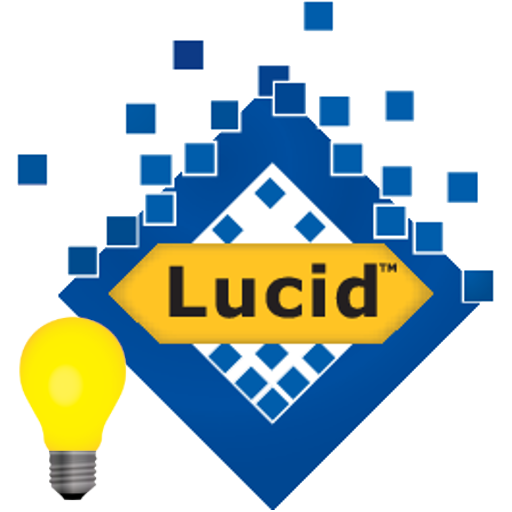Glossary Terms Report
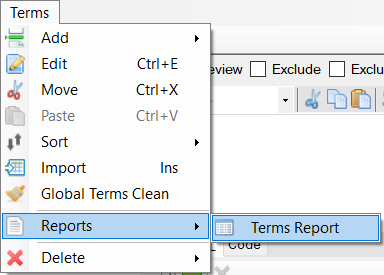
The Terms Report will report on all the terms for the selected Glossary Set. The report will cover the term properties such as ‘Review’, ‘Exclude’ and ‘Alias Of’ etc. It will also give a media attachment count for each term.
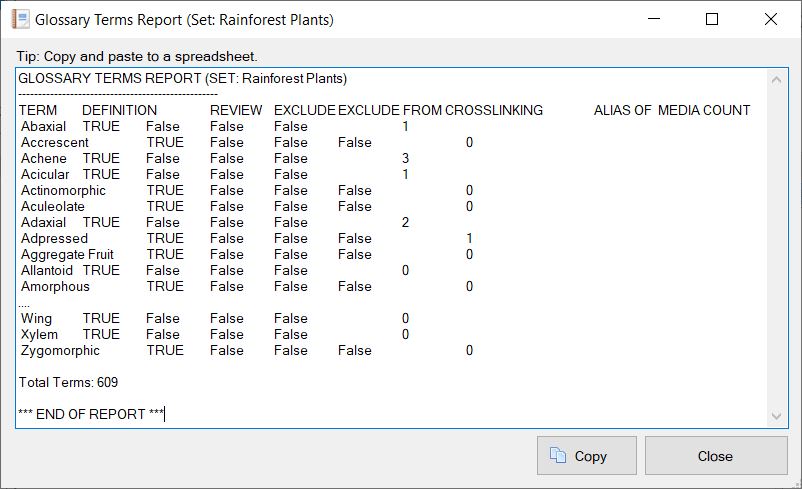


The Terms Report will report on all the terms for the selected Glossary Set. The report will cover the term properties such as ‘Review’, ‘Exclude’ and ‘Alias Of’ etc. It will also give a media attachment count for each term.


If selected, a glossary page will be created listing Glossary Sets and their associated terms.
This assumes that the selected Export Template supports Glossary creation.
Often glossary terms are used within the definition of other glossary terms. If this option is selected, glossary terms are cross-linked, allowing users to easily jump between terms or to view a glossary term definition, via a Glossary Pop-up.
If selected, any Entity names used within the glossary will be cross-linked back to their corresponding fact sheet.
If selected, this option will add an additional class name to the glossary cross-links. This can then be used by an Export Template JavaScript, if supported, to create a tool tip box containing the terms’ definitions, when the mouse hovers over the link.
This option allows you to override any glossary terms that have been marked for exclusion within the Glossary Manager.
This option allows you to exclude any terms that have been marked for Review in the Glossary Manager.
By default Glossary Sets are exported, unless marked as excluded by this export option. To exclude the Glossary Set check (tick) the corresponding box on the left hand side of the Glossary Set name.
Please see the Media Override Options for further information on this topic.

Once you have finished entering your data and media for the fact sheets it is time to export. The export dialog has many options to customize the fact sheets. Each set of related options have been grouped under tabs within the export dialog.

The Glossary Manager is where you can manage all the glossary terms associated with your project. You can access the glossary manager via the main interface menu Edit…Glossary Manager (Ctrl+G). Alternatively you can access the Glossary manager
(![]() ) from a toolbar.
) from a toolbar.

The Glossary preview option will export the glossary sets and allow you to preview the exported glossary page (e.g. glossary.htm; glossary.xml or glossary.pdf) in your preferred web browser or PDF reader. Before the glossary can be exported, a minimum set of export preferences need to be defined. If these export preferences have not yet been set, the export dialog will automatically open to allow you to set your preferences. For example, you must select an export template and destination. You may specifically set your glossary export preferences relating to cross linking in the export dialog under the Glossary tab. For more information on this please see the Export dialog help.
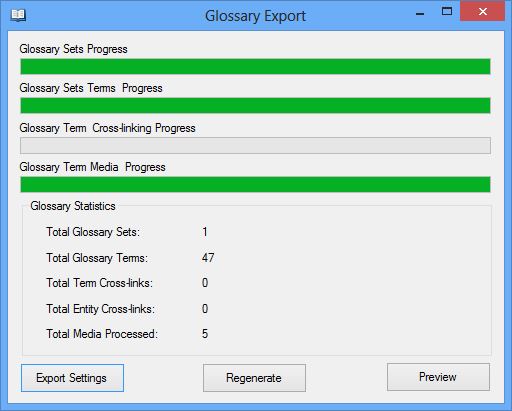
The export progress will be shown for Glossary Sets, Terms, Cross-linking and media processing. Once the glossary export has completed a set of simple export statistics will be shown and the preview button will become enabled.
Export Settings – Will open the Export Settings dialog allowing you to make any export adjustments.
Regenerate – This will cause the glossary to be exported again. This is useful if you have made changes to the export settings since the last preview.
Preview – This will open the exported glossary in either your preferred web browser; Or, if exported as a PDF, your preferred PDF reader.
This will open the media manager. Please see the Media Manager for further information on this topic.
This option will open the watermark manager. Please see the Image Watermark Manager for further information on this topic.
A glossary set is a container for glossary terms. To enter glossary terms requires at least one glossary set. Multiple glossary sets are useful if you wish to group related terms within the exported glossary page. For example, if you were creating a set of fact sheets that covered both plants and animals you may want to create a specific set of terms for each of these groups as they may have terms that are the same but with different definitions. Or as another example you may just wish to group novice and expert terminology separately. Normally each Glossary Sets has it own alphabetical index within the glossary as shown in the example below. However this is entirely determined by the underlying export template.
There are a number of ways to add a Glossary Set:

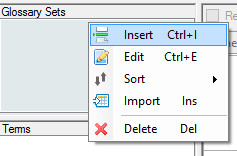
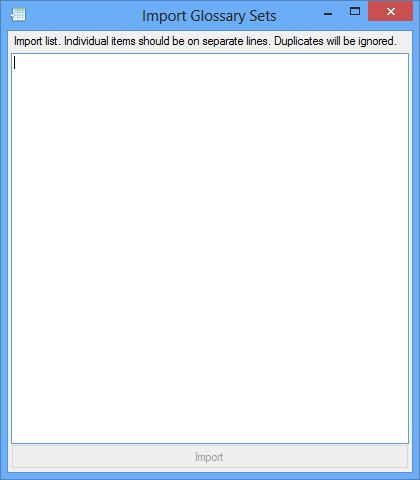
Duplicate set names are not allowed within the same project.
Once a Glossary Set has been added you can edit its name at anytime. To rename a Glossary Set select it, then from the Set menu or context pop-up menu (Ctrl+E) select the Edit option.

You can sort Glossary Sets alphabetically (Ascending or Descending) or manually sort them via drag and drop. The alphabetical sort options are available via the Set menu or the context pop-up menu. To sort manually select the desired Glossary Set then hold down the left mouse button and drag the Glossary Set to the preferred position in the Glossary Set list, then let go of the mouse button to drop it into position.
Highlight the Glossary set you wish to delete then either select the delete option from the Set menu, context pop-up menu, or simply press the delete key on your keyboard. You will receive a deletion confirmation warning before the delete occurs. You should make special note that all Glossary Terms within the Glossary Set will also be deleted. There is no undo to this action. You may want to move Glossary Terms from the Glossary Set prior to deleting. For more information on moving Glossary Terms see the Glossary Terms section below.
Glossary Terms are made up of a term and its definition. In order to add Glossary Terms you must define one or more Glossary Sets. You can add Glossary Terms in several different ways.
Select the desired Glossary Set you wish to add the term to. Then you can add the Term by either:


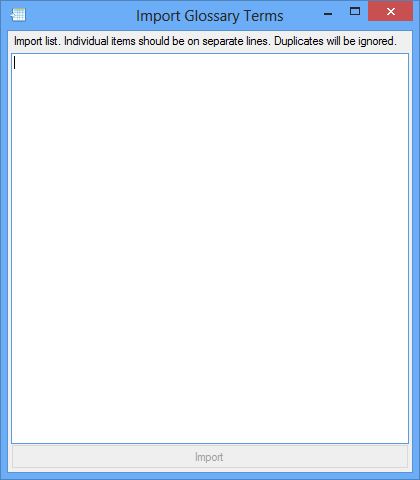
Duplicate Terms are not allowed within the same Glossary Set.

The definition is the explanatory text of the Term. Definition text is HTML based with the standard HTML editor options.

If a term is marked for Review, this can be used to determine if it should be included in the export process.
This marks a Term that should be excluded in the export process. Note: It is possible to override records marked as Excluded in the Export dialog, if desired.
If checked, this option will prevent the export process from cross-linking other terms and entities within the definition text.

Aliases are alternative names to a given term. This allows the entry of additional related term names without duplicating the definition. It also allows the possibility of cross-linking where this alternative name is used within other terms or fact sheet topics. To create an alias term, create a new term, then simply select the root term from the ‘Alias Of’ drop down list. This alias term will then inherit the root terms properties and disable the term options such as Review and Exclude. To change an alias term back to a regular term, select the ‘Not an Alias’ from the ‘Alias Of’ drop down list.
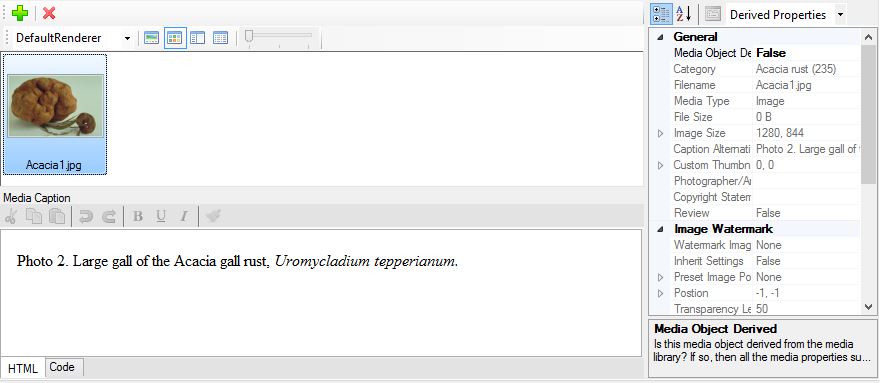
One or more media items can be linked to a Term. Media Properties are accessible via the Glossary media panel along with the Media Caption. Please see Media and Media Manger help topics for further details on dealing with media.
If the Media Properties and/or Media Caption are read-only, then they are currently being inherited from the Media Manager. If you need to customize the caption text or media properties just for this instance, then set the media object derived properties to True.

The HTML Editor is ‘text’ editor for the entering topic text and caption text within your project.


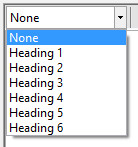
The heading selector allows you to select between several standard heading sizes. The heading size is applied to the currently selected line. A heading size can be removed by selecting the ‘None’ option. The heading size and style in the editor are only indications of the heading style. The selected fact sheet template will define the actual size and font type.
![]()
Any highlighted text will be cut from the editor to the clipboard.
Any highlighted text will be copied to the clipboard.
If the clipboard is not empty then the contents of the clip board will be pasted at the position of the cursor.
Use Ctrl + Shift + v keyboard combination to paste formatted content as plain text. E.g. MS Word or HTML clipboard content.
Will undo the last action performed. If the Undo button holds a history of steps performed within the editor, you can undo actions performed, such as delete, paste and typing, until the history is exhausted.
The redo action will redo any step that may have been undone by the Undo action.
Increases the importance of any selected text or makes any new text important from where the cursor is located. To remove bold text, highlight the desired portion and select bold again.
Underlines any text selected; or makes any new text underlined from where the cursor is located. To remove underline from text, highlight the desired portion and select underline again.
Emphasizes any selected text; or makes any new text italicized from where the cursor is located. To remove italics from the text, highlight the desired portion and select italic again.
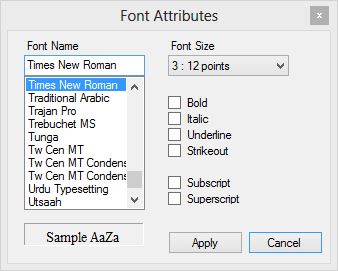
The edit font dialog will allow you to change the underlying font settings. However it is recommended that this facility is used only where absolutely necessary. Defining font settings within the HTML content will override the export template. Therefore it would be possible to cause a mis-match of font types within the exported fact sheet.
The Normal option removes any applied font styling from the selected text.
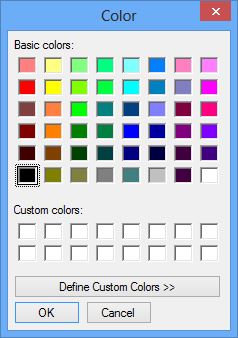
The font color dialog will allow you to change the font color of the selected text. However any font styling, including color, will override the export template.
This will increase the selected text font size incrementally each time it is selected. You can remove font sizing via the Normal option or reduce the font size using the Decrease font size option.
This will decrease the selected text font size incrementally each time it is selected. You can remove font sizing via the Normal option or increase the font size using the Increase font size option.
Positions selected text to the left of the text edit area.
Positions text center in the text edit area.
Positions text to the right of the text edit area.
Moves the text a fixed amount to the right equivalent of one tab.
Moves the text a fixed amount to the left equivalent of one tab.
This option starts a numbered list. Each new line within the list is automatically assigned the next sequential number. The Indent and Outdent options can be used within the ordered list to create sub lists with their own sequential values.
This option starts an unordered (bullet) list. Each new line within the list is automatically assigned a bullet icon. The Indent and Outdent options can be used within the ordered list to create sub lists with their bullet style. The style applied to each level within the list is determined by the web browser and the font used. This styling can be, easily overridden by the export template.
This option inserts a horizontal line at the position of the cursor.

This dialog allows you to define the properties of a table to be inserted into the text edit area. Once the table has been created it can be easily modified by right clicking within the table area and selecting the table edit options.
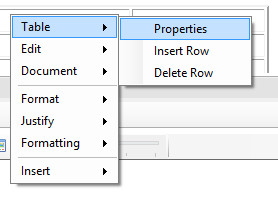
This option has been disabled in this edition and may be added in a future release. If you wish to associate an image with a topic you can do so via the Topic Image tab or an image can be associated with the entity. The selected export template will then determine the layout and positioning of the image. Alternatively if you do wish to embed an image from an Internet location you can use the editing pop-up context menu to insert an image. If an image is embedded this way, the browser loading the exported page will need Internet access to display the image.

This options allows you to create a link on highlighted text. If you are creating a link you can set the target (i.e. New window or the same window). The Href (hyperlink) should be a fully qualified URL (e.g. https://www.lucidcentral.org)
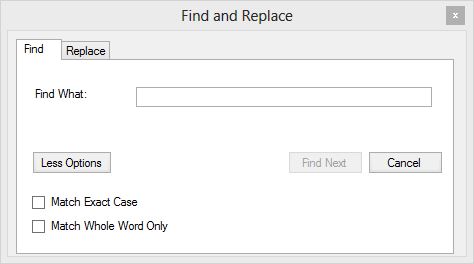
The find dialog will search for given text within the current editor’s text area.
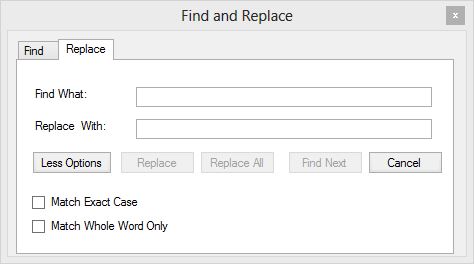
The replace option allows you to perform a find and replace within the current text area.
This option allows you to print the current text area content. It will open a print dialog allowing you to select your preferred printer and page options.
Often when Microsoft Word content (or content of other Office applications) is pasted into the HTML editor, it is pasted with Microsoft Office HTML formatting, which will override the exported fact sheet template styles. The Clean HTML function is designed to remove most Microsoft Word HTML formatting, leaving the equivalent styling where possible, but without the use of embedded styles. This will leave the formatted content looking similar to “plain text”, but will generally look much better in the exported format once the template has been applied.
Also see Global Topic Clean options.

The Code tab within the HTML editor allows you access to the underlying HTML markup of the document. If you are comfortable with HTML you can edit the HTML markup directly. Switching back to the HTML tab will update the document with any changes that have been made. It is very important to maintain well formed HTML code within the HTML editor. That is, each HTML tag must have a start and end tag (other than breaking return tags (<br>) and horizontal lines (<hr>)).
If errors are made in the simple mark up, the editor will try and correct for this, i.e. append missing end tags, although in more complex tags, such as tables etc, this may not work. If “broken” HTML tagging is left within the editor this may affect the exported fact sheet with either an error when exporting or unexpected layout and formatting.


The preview button automatically exports the selected entity as a fact sheet using the current export settings. Once the export has completed, the fact sheet will be loaded into the default web browser or PDF reader (depending on the export output type). If the minimum export settings have not yet been entered the export dialog will be automatically opened. The export settings then need to be adjusted before the preview can be completed.
The Export button will open the Export dialog allowing you to adjust the various export settings and perform a full export your fact sheets. See the Export help topic for further information on exporting fact sheets.
The Glossary Manager button opens the Glossary Manager dialog allowing you to enter glossary sets, terms and definitions for your fact sheets. See the Glossary Manager help topic for further information.
The Media Manager button will open the Media Manager dialog where you can add, edit and remove media associated with the fact sheets. See the Media Manager help topic for further information.
The Image Watermark Manager button opens the Image Watermark Manager dialog where you can manage the image watermarks and their default settings for your project. See the Image Watermark Manager help topic for further information.
